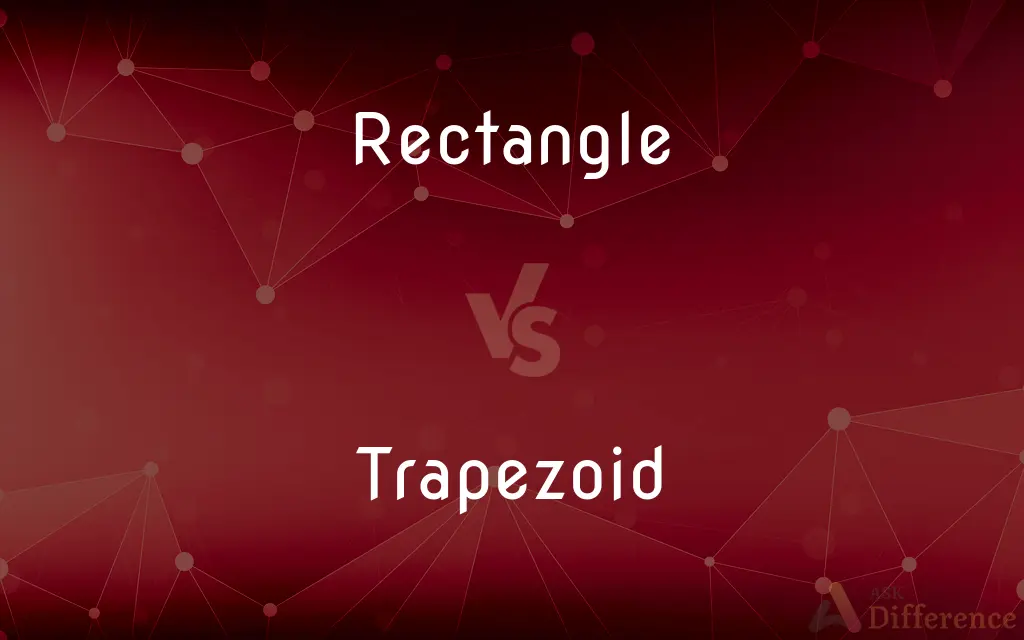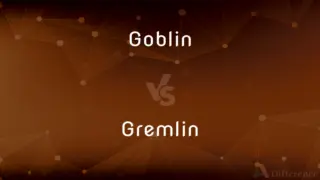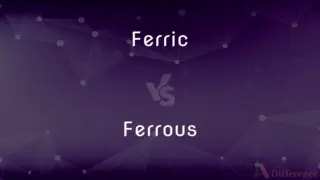Rectangle vs. Trapezoid — What's the Difference?
By Tayyaba Rehman & Fiza Rafique — Updated on April 15, 2024
A rectangle is a quadrilateral with four right angles and opposite sides equal, while a trapezoid (US) or trapezium (UK) has at least one pair of parallel sides.

Difference Between Rectangle and Trapezoid
Table of Contents
ADVERTISEMENT
Key Differences
A rectangle is defined by its four right angles, making all angles 90 degrees, whereas a trapezoid is characterized by having at least one pair of parallel sides, with the other sides generally not parallel.
In a rectangle, opposite sides are not only parallel but also of equal length, which ensures its shape is always a parallelogram. On the other hand, in trapezoids, the non-parallel sides can be of different lengths, which affects the symmetry and overall shape.
Rectangles can be divided into two congruent right-angled triangles by a diagonal, which is also a line of symmetry. In contrast, trapezoids generally lack such symmetry unless they are isosceles trapezoids, where the non-parallel sides are equal in length.
The area of a rectangle is calculated by multiplying its length by its width. For a trapezoid, the area formula is more complex, involving the average of the lengths of the two parallel sides and the height between them.
Both shapes are commonly studied in geometry, but rectangles have a stronger presence in everyday applications such as screens and paper dimensions, while trapezoids are often used in architectural designs and engineering to provide structural diversity.
ADVERTISEMENT
Comparison Chart
Definition
A quadrilateral with four right angles.
A quadrilateral with at least one pair of parallel sides.
Angle Properties
All angles are 90 degrees.
Angles vary; adjacent angles on non-parallel sides are supplementary in a simple trapezoid.
Side Properties
Opposite sides are equal and parallel.
Only one pair of sides is parallel; other sides are not necessarily equal or parallel.
Symmetry
Symmetrical about diagonals.
Typically asymmetrical, unless isosceles.
Area Calculation
Area = length × width.
Area = 0.5 × (sum of parallel sides) × height.
Compare with Definitions
Rectangle
A parallelogram with right angles.
A standard piece of paper is often a rectangle.
Trapezoid
A quadrilateral with at least one pair of parallel sides.
The base of a bridge might be designed as a trapezoid for stability.
Rectangle
Opposite sides are equal and parallel.
The screen of a smartphone is typically rectangular.
Trapezoid
Can be isosceles with equal non-parallel sides.
An isosceles trapezoid has a line of symmetry between the parallel sides.
Rectangle
Diagonals bisect each other and are equal.
In a rectangle, the diagonals split the figure into four right triangles.
Trapezoid
Useful in various construction and design contexts.
Trapezoidal shapes are used in trusses for roofs.
Rectangle
Used extensively in everyday life.
Most windows are shaped as rectangles.
Trapezoid
Sides and angles can vary significantly.
Some trapezoids in graphic designs have dramatically sloped non-parallel sides.
Rectangle
Represents order and efficiency in design.
Books are usually rectangular to optimize handling and storage.
Trapezoid
Adds visual interest and complexity.
Trapezoidal forms are often used in modern architecture to create dynamic and eye-catching structures.
Rectangle
In Euclidean plane geometry, a rectangle is a quadrilateral with four right angles. It can also be defined as: an equiangular quadrilateral, since equiangular means that all of its angles are equal (360°/4 = 90°); or a parallelogram containing a right angle.
Trapezoid
In Euclidean geometry, a convex quadrilateral with at least one pair of parallel sides is referred to as a trapezium () in English outside North America, but as a trapezoid () in American and Canadian English. The parallel sides are called the bases of the trapezoid and the other two sides are called the legs or the lateral sides (if they are not parallel; otherwise there are two pairs of bases).
Rectangle
A plane figure with four straight sides and four right angles, especially one with unequal adjacent sides, in contrast to a square.
Trapezoid
A quadrilateral having two parallel sides.
Rectangle
A four-sided plane figure with four right angles.
Trapezoid
Chiefly British A trapezium.
Rectangle
(geometry) Any quadrilateral having opposing sides parallel and four right angles.
Trapezoid
(Anatomy) A small bone in the wrist, situated near the base of the index finger.
Rectangle
(nontechnical) Such a quadrilateral that is oblong (longer than it is wide): one that is not regular (equilateral), that is, any except a square.
Trapezoid
(Sports) An area in the shape of a trapezoid marked behind the goal line and the goal in ice hockey, where the goalie is allowed to play the puck.
Rectangle
A four-sided figure having only right angles; a right-angled parallelogram.
Trapezoid
A (convex) quadrilateral with two (non-adjacent) parallel sides.
Rectangle
Rectangular.
Trapezoid
A convex quadrilateral with no sides parallel.
Rectangle
A parallelogram with four right angles
Trapezoid
(anatomy) The trapezoid bone of the wrist.
Trapezoid
A plane four-sided figure, having two sides parallel to each other.
Trapezoid
A bone of the carpus at the base of the second metacarpal, or index finger.
Trapezoid
Having the form of a trapezoid; trapezoidal; as, the trapezoid ligament which connects the coracoid process and the clavicle.
Trapezoid
Of or pertaining to the trapezoid ligament; as, the trapezoid line.
Trapezoid
A quadrilateral with two parallel sides
Trapezoid
The wrist bone between the trapezium and the capitate bones
Common Curiosities
What defines a rectangle?
A rectangle is defined by having four right angles and opposite sides that are equal and parallel.
How do you calculate the area of a rectangle?
The area of a rectangle is calculated by multiplying its length by its width.
What defines a trapezoid?
A trapezoid is defined by having at least one pair of parallel sides.
What is the difference in symmetry between a rectangle and a trapezoid?
A rectangle is symmetrical about its diagonals, while a trapezoid is generally not, unless it is isosceles.
Are the diagonals of a trapezoid equal?
In general, the diagonals of a trapezoid are not equal, unlike in a rectangle.
Can a rectangle be a trapezoid?
Technically, a rectangle can be considered a special type of trapezoid with two pairs of parallel sides.
What role do rectangles and trapezoids play in architecture?
Rectangles are fundamental in architectural design for practical structures, while trapezoids can be used to enhance aesthetic appeal and structural uniqueness.
How do the properties of rectangles and trapezoids affect their applications?
The properties of rectangles make them ideal for stable and efficient designs, while the properties of trapezoids offer unique structural and aesthetic possibilities.
What is the significance of right angles in rectangles?
Right angles in rectangles ensure uniformity and predictability, important in many practical applications.
How do you calculate the area of a trapezoid?
The area of a trapezoid is calculated as half the product of the sum of the lengths of the parallel sides and the height between them.
Why might a designer choose a trapezoid over a rectangle?
A designer might choose a trapezoid for its dynamic shape and to add visual interest or accommodate specific structural needs.
Why are rectangles commonly used in design?
Rectangles are favored in design due to their simplicity, symmetry, and the efficient use of space.
What is an isosceles trapezoid?
An isosceles trapezoid is a trapezoid where the non-parallel sides are equal in length, often making it symmetric.
Can trapezoids be found in nature?
Natural trapezoids are less common but can occur in geological formations and certain types of crystals.
How do the non-parallel sides of a trapezoid influence its design?
The non-parallel sides of a trapezoid introduce complexity and can influence structural dynamics and aesthetic perceptions.
Share Your Discovery

Previous Comparison
Goblin vs. Gremlin
Next Comparison
Ferric vs. FerrousAuthor Spotlight
Written by
Tayyaba RehmanTayyaba Rehman is a distinguished writer, currently serving as a primary contributor to askdifference.com. As a researcher in semantics and etymology, Tayyaba's passion for the complexity of languages and their distinctions has found a perfect home on the platform. Tayyaba delves into the intricacies of language, distinguishing between commonly confused words and phrases, thereby providing clarity for readers worldwide.
Co-written by
Fiza RafiqueFiza Rafique is a skilled content writer at AskDifference.com, where she meticulously refines and enhances written pieces. Drawing from her vast editorial expertise, Fiza ensures clarity, accuracy, and precision in every article. Passionate about language, she continually seeks to elevate the quality of content for readers worldwide.














































